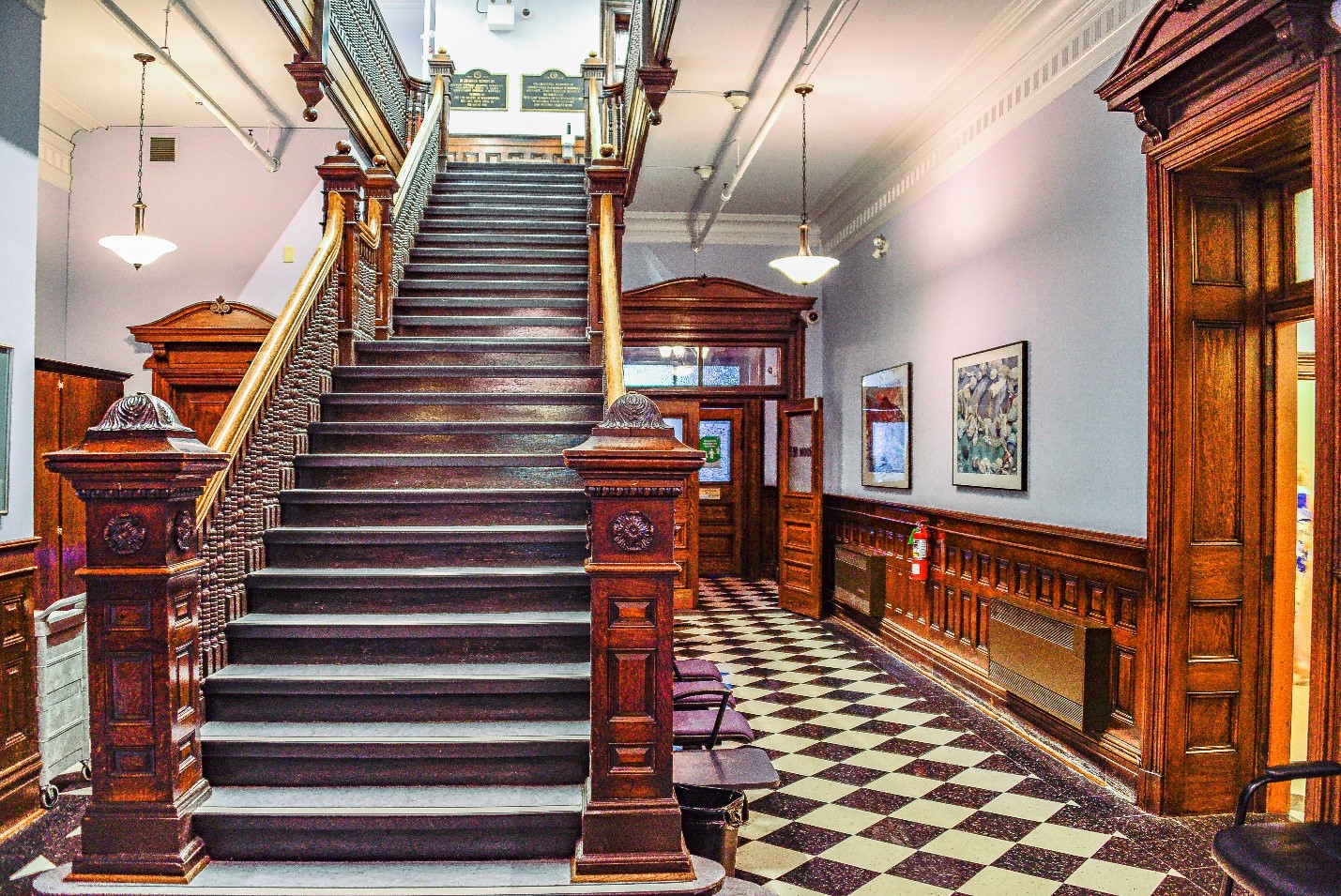 General Division
General Division
The first permanent Courthouse in St. John’s opened in September, 1730. It housed a wooden jail and Courthouse. It remained as such for 100 years and was situate at 309 Duckworth Street, St. John’s, on approximately the same site as the present Courthouse.
In 1831, Governor Thomas Cochrane arranged for the building of a new Courthouse and jail on the same site where Osborner’s hostelry for the miscreants stood. That second St. John’s Courthouse, with its custodial accommodations, was a wooden structure, two storeys in height.
In 1846, this Courthouse was destroyed by fire. In 1847, construction began on a three-storey market house on the burned-out site.
The 1847 market house and Courthouse were destroyed by fire on July 8, 1892, along with three-quarters of St. John’s. As a result, Supreme Court sittings were held in the Colonial Building between sessions of the Legislature from 1892 to 1894. These arrangements were not convenient and during 1892-1893, Superintendent of Public Buildings, John T. Neville, prepared plans for a temporary wooden Courthouse which would eventually become the Star of the Sea Hall on Henry Street. Although the structure was built for the Star of the Sea Association, the Government rented the premises until May, 1904.
It was decided by the government of the day during the Summer of 1899 to create plans for a new Courthouse in St. John’s at an estimated cost of $100,000.00.
Shortly thereafter, it was announced that the Duke of York, who would late become King George V, would visit St. John’s whereupon arrangements were made to have him participate in a cornerstone ceremony for the Courthouse. A 14k gold trowel was made by P. W, Ellis & Company of Toronto for the occasion. The cornerstone was laid by His Royal Highness on October 24, 1901.
Construction of the new Courthouse continued throughout 1902 and 1903. The clock, with its four faces, was installed by clockmaker, J. Roper, and set in operation about the middle of August, 1903, by St. John’s Mayor George Shea. The building was officially opened May 2, 1904, at exactly noon when Chief Justice Sir William Horwood, together with Justices George Henry Emerson and George MacNess Johnson took their places on the bench.
At that time, the completed building was not used exclusively by the courts. It contained one Supreme Courtroom, namely Courtroom No. 1, a Police Court – subsequently known as the Magistrate’s Court (which is now Courtroom No. 4), Court Chambers, a Law Library, Judges’ Apartments (now designated as Judges’ Chambers), police offices and accommodations for court staff.
In addition to the courtrooms and other court related accommodations, the building was occupied by the Prime Minister, the Colonial Secretary and Cabinet. In 1934, the former Executive Council Chamber (i.e. the Cabinet Room) situate on the second floor was converted into what is now No. 2 Supreme Courtroom. During the term of Commission of Government, several floors in this building were occupied by Government departments, which occupancy continued until the opening of Confederation Building in 1960.
A large area of the floor immediately below Courtroom No. 1 was occupied by the Department of Public Works which at that time included a Highways Division. The entire division of Highways was on the top floor of this building while the area now occupied by the Registry of the Supreme Court which is on the bottom floor was also a part of the Department of Public Works.
The floor above Courtroom No. 1 housed the Registry of Deeds, Companies and Securities which consisted of a very small room and a vault. The Registry of Deeds, Companies and Securities moved to Confederation Building in 1960 and now occupies an entire wing of the bottom floor of that Building.
Today the Courthouse is used exclusively by the Supreme Court of Newfoundland and Labrador, except for a portion of it in its basement area which houses the City Lockup.
The High Sheriff originally occupied what is now a Judges’ Chambers on the southeast corner of the building on the third floor. His office was subsequently moved to the fourth floor of the building but as the Court continued to expand, the High Sheriff and his staff were obliged to move out and now have offices situate at 319 Duckworth Street, three doors to the west of the Courthouse on Duckworth Street.
This historic Courthouse has been the scene of many great trials since it opened nearly a century ago.
On June 18, 1988, the Courthouse was declared a national historic site. A plaque was unveiled at the time commemorating its national historic and architectural significance. The building has been declared to be of historic significance by the Historic Sites and Monuments Board of Canada.
In 1989, all of the stone was cleaned and joists repaired with the result that this historic temple of Newfoundland and Labrador justice continues to rank as one of Canada’s most beautiful Courthouses and one of St. John’s most impressive landmarks.
[As extracted and precised by Christopher Curran, Q.C. from the text of a speech given by former Chief Justice Hickman to the Newfoundland Historic Society on February 26, 1998.]